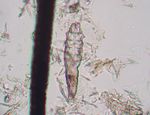Demodex
| Demodex spp. | |
|---|---|
| Kingdom | Animalia |
| Phylum | Arthropoda |
| Class | Arachnida |
| Sub-class | Acari |
| Super-order | Acariformes |
| Sub-order | Prostigmata |
| Super-family | Cheyletoidea |
| Family | Demodecidae |
| Genus | Demodex |
| Species | D. canis, D. aurati, D. criceti, D. bovis |
Introduction
Demodex spp. are found on all domestic mammals as well as in humans and are usually a commensal organism. It is a burrowing mite as opposed to a surface mite meaning that it penetrates into the host's tissue. Each host has a specific species of the Demodex mite. A clinical infection of Demodex spp. is termed demodicosis.
Identification
The Demodex species have a distinctive cigar shaped appearance under microscopic examination. They have four pairs of stumpy legs on the anterior portion of the body.These species are Prostigmata, with their breathing apparatus on the anterior portion of their bodies. Prostigmata is a suborder of the class Acari containing mites with anterior breathing apparatus. This distinctive long and narrow appearance allows them to burrow into and remain inside hair follicles. The eggs are also laid into the hair follicles and look relatively long and spindle shaped.
Detection
Detecting Demodex species on animals requires the use of either a deep skin scrape or a hair pluck. These samples can then be prepared in liquid paraffin and analysed under a microscope. Detection of a single mite is not diagnostic as they are common commensals, instead the observation of concurrent clinical signs should be used to diagnose demodicosis.
Life cycle
Demodex species complete their entire life cycle within the hair follicles and sebaceous glands of a single host. Their life cycle takes 3 weeks to complete. The female lays 20-24 eggs at a time into hair follicles. Larvae are hexapod and have 3 larval stages before becoming adult.
Transmission between hosts occurs by close contact. Usually these mites will be commensals of the host from a young age due to maternal transfer to the neonate during suckling.
Important Species
Demodex canis
- This is by far the most commonly seen species of Demodex causing clinical problems. Its host species is the dog and demodicosis is usually a secondary opportunistic pathogen due to other underlying conditions.
Demodex criceti & Demodex aurati
- Cause hairloss in hamsters.
Demodex bovis
- Causes pea shaped nodules in cattle.
Demodex merioni
- Causes hairloss in gerbils.
| Demodex Learning Resources | |
|---|---|
 Test your knowledge using flashcard type questions |
Mites Flashcards |
 Search for recent publications via CAB Abstract (CABI log in required) |
Demodex publications |
| This article has been peer reviewed but is awaiting expert review. If you would like to help with this, please see more information about expert reviewing. |
